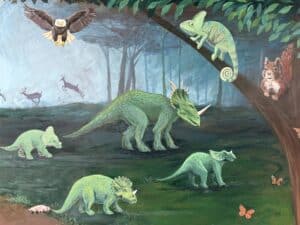The Old Testament: Trustworthy Treasure
As a creation museum, we encounter many questions about the Bible. While many of these center around interpreting Genesis or explaining why evolution falls short as a theory of origins, we do occasionally hear doubts about the preservation of the Old Testament. In other words, after all, how do we know Genesis has been accurately preserved in the 3,500 years since Moses penned it? Even if it originally started as reliable history of the world and mankind, how can we know it hasn’t been changed, altered, or corrupted through centuries of copying?
God’s Promises About His Word
 Before digging into the scientific data that pertains to our question, we need to establish a truth about the Bible that sets it apart from any other literature. This book has a supernatural Author Who promised to supernaturally guard the Word He supernaturally inspired. This automatically makes its history and legacy very different from other ancient documents such as The Epic of Gilgamesh or The Instructions of Ptahotep.
Before digging into the scientific data that pertains to our question, we need to establish a truth about the Bible that sets it apart from any other literature. This book has a supernatural Author Who promised to supernaturally guard the Word He supernaturally inspired. This automatically makes its history and legacy very different from other ancient documents such as The Epic of Gilgamesh or The Instructions of Ptahotep.
One such example of God’s promise to preserve His word is in Psalms:
“The words of the Lord are pure words, like silver
tried in a furnace of earth, purified seven times.
You shall keep them, O Lord, You shall preserve
them from this generation forever.”
Psalm 12:7
Jesus Himself reaffirms this promise in Matthew 5:18:
“For assuredly, I say to you, till heaven and earth
pass away, one jot or one tittle will by no means
pass from the law till all is fulfilled.”
Internal Evidence for Preservation
As for the scientific data on the reliability of the Old Testament, multitudes of books have been written on this subject. What we will cover in the two parts of this article is not even a feather’s scratch of the surface, but in this vast sea of scientific data, we will turn our attention to the Hebrew text of the Old Testament and how we can trace its preservation through the ages.
 First, we have the internal witness that God kept the Hebrew Scriptures (a.k.a. Old Testament) from corruption all through the thousand year span they were written, starting when Moses recorded the Pentateuch (Genesis-Deuteronomy) through the time of Ezra after the return of the Babylonian Captivity (B.C. 458). While many prophets were sent by God to warn Israel and Judah of their sins corrupting the holy scriptures was never one that was mentioned. Furthermore, Jesus also reproved the Jews for many things, but never once did He chastise them for adulterating or losing God’s word. Rather, He quoted extensively from the Old Testament and used it as the bases for his rebukes.
First, we have the internal witness that God kept the Hebrew Scriptures (a.k.a. Old Testament) from corruption all through the thousand year span they were written, starting when Moses recorded the Pentateuch (Genesis-Deuteronomy) through the time of Ezra after the return of the Babylonian Captivity (B.C. 458). While many prophets were sent by God to warn Israel and Judah of their sins corrupting the holy scriptures was never one that was mentioned. Furthermore, Jesus also reproved the Jews for many things, but never once did He chastise them for adulterating or losing God’s word. Rather, He quoted extensively from the Old Testament and used it as the bases for his rebukes.
Finally, Paul gives us a clear statement on the trustworthiness of the Old Testament in 2 Timothy 3:16-17, where we learn “ALL” scripture is profitable for use in the church for the instruction and correction of the believers. As one of the most learned Jews of his time, Paul would have known well the history of his people, their scriptures, and their accuracy in his own day. He never once questioned it. Many other internal evidences could be given and I encourage those so interested to look up the scholarly articles by Dr. Brian Edwards at www.answersingenesis.org. Such examples included the unique monotheist theme of the Old Testament; the painfully honest records of Israel’s heroes, kings, and leaders; and its incredible consistency across writers, cultures, and locations.
The respected ministry, Institute for Creation Research, sums up the historical evidence for the Old Testament’s preservation this way:
“There is more evidence for the Bible’s authenticity than for any literature of antiquity. Textual analysis begins with historical investigation, beginning with the latest documents and working backward. As evidence develops, the data is evaluated against other sources. The record is then checked for consistency of information, and the claims are analyzed as if it were a legal case, looking for credible testimony with cross-examination. There is an enormous amount of evidence for authenticity of the biblical manuscripts…”
The field of “textual analysis” follows these lines exactly. Currently, we have lists of Old Testament manuscripts numbering in the several hundreds, the most famous being the Dead Sea Scrolls. In part two of this article, we will dive into these early manuscripts, copying customs of the scribes, scholars’ perspectives on the discoveries in the Judean Desert, and comparing the Old Testament to other ancient writings that have survived to the present day.



 Before digging into the scientific data that
Before digging into the scientific data that  First, we have the internal witness that God kept
First, we have the internal witness that God kept 


